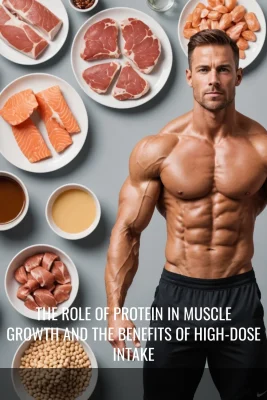The Role of Protein in Muscle Growth and the Benefits of High-Dose Intake

Introduction
Protein is a vital component in building and maintaining muscle mass. We have long believed that consuming more than 40 grams of protein in a single meal would result in the excess protein being burned off or oxidized. However, recent research challenges this notion, suggesting that high-dose protein intake can actually have significant benefits for muscle growth. In this article, we will delve into the latest findings on protein metabolism and discuss the importance of protein timing and distribution.
The Anabolic Response to Protein Intake
When it comes to muscle growth, protein is crucial. Studies have shown that the anabolic response is very clear with the first 20 grams of protein consumed, resulting in significant muscle growth. As protein intake increases from 20 to 40 grams, there is a diminishing return in terms of muscle gains. However, recent research has challenged this protein threshold, suggesting that higher protein doses may have additional benefits for muscle growth.
The Limitations of Previous Studies on Protein Consumption
Previous studies on protein consumption focused on a single meal and measured the anabolic response over a period of 4 to 5 hours. This approach failed to consider the impact of longer digestion times for high-dose protein intake. Furthermore, these studies often overlooked the fact that protein burn-off or oxidation is minimal, even with higher protein intakes. Therefore, it is important to reevaluate the existing data and examine the effects of consuming higher amounts of protein in a single sitting.
The Study on High-Dose Protein Intake
Professor Yor Tromlin, a renowned researcher in protein metabolism at Maastricht University in the Netherlands, conducted a groundbreaking study comparing the ingestion of 25 grams of milk protein to 100 grams of milk protein. The study aimed to determine the metabolic fate of protein consumed in high doses and whether it would lead to wastage or be utilized effectively for muscle growth.
The Four Steps of Protein Utilization in the Body
Before we delve into the study’s findings, it is important to understand the four steps involved in the body’s utilization of protein. First, protein is ingested and undergoes mechanical digestion in the mouth and stomach, breaking it down into smaller particles. Then, gastric glands in the stomach secrete hydrochloric acid, unraveling the protein bonds. Subsequently, the protein enters the small intestine, where it undergoes the final stages of digestion. Finally, free amino acids are absorbed through the intestinal wall and released into the bloodstream, ready for utilization.
The Results of the Study on Milk Protein Intake
The study conducted by Professor Yor Tromlin and his colleagues investigated the metabolic fate of protein ingested in high doses. Participants performed a lifting session followed by the ingestion of either 25 or 100 grams of milk protein. The researchers monitored blood samples and muscle biopsies for up to 12 hours after protein consumption to determine where and how the protein was metabolized in various tissues.
The results were surprising. Despite the significantly higher protein intake in the 100-gram group, not much additional protein was oxidized. In fact, the amount of amino acids reaching circulation was proportionate to the protein consumed. Moreover, the enrichment of all types of protein in various tissues was substantially higher in the 100-gram group compared to the 25-gram group.
Protein Digestion and Absorption in the Body
Protein digestion starts in the mouth and stomach, followed by the small intestine, where free amino acids are absorbed into the bloodstream. From there, amino acids are transported throughout the body for one of two uses: protein synthesis in different tissues and organs or energy production through oxidation.
The Role of Amino Acids in Protein Synthesis
Protein synthesis is a complex process involving the incorporation of amino acids into muscle fibers, leading to muscle growth. The study revealed that in the 0 to 4-hour timeframe, the 100-gram group had 20% higher protein synthesis rates compared to the 25-gram group. In the 4 to 12-hour timeframe, the 100-gram group experienced a 40% greater increase in protein synthesis.
The Differences Between 25g and 100g Protein Intake
The study clearly demonstrated that ingesting 100 grams of protein in a single sitting does not result in wasted protein. In fact, even over 12 hours after ingestion, protein was still being released into circulation. Additionally, substantially more protein was used for increasing muscle protein synthesis in the 100-gram group compared to the 25-gram group.
Protein Oxidation and Energy Metabolism
Protein oxidation refers to the process of amino acids being burned for energy. While protein can serve as a source of energy, carbohydrates and fats are the body’s preferred fuel sources. Protein oxidation occurs when amino acids undergo deamination in the liver, creating keto acids that can be used for various purposes in energy metabolism.
The Significance of Timing Protein Consumption
Previously, protein distribution and timing were believed to be crucial factors in maximizing muscle growth. However, more recent research, including studies on intermittent fasting, suggests that protein timing may not be as significant as once thought. While protein timing has not been shown to have a major impact on muscle mass, it is still recommended to aim for four meals a day to ensure adequate protein intake.
The Recommended Meal Distribution for Protein Intake
Professor Yor Tromlin suggests a simple approach of consuming four meals per day: breakfast, lunch, dinner, and an additional meal prior to sleep. This four-meal approach can help provide sufficient protein distribution throughout the day and may optimize anabolism. While the specific timing of protein intake may not have a significant impact, this approach ensures consistent protein consumption without the need for complex meal patterns.
Where to Find More Information on Protein and Nutrition
If you found this article interesting, you might enjoy our newsletter, which provides free bi-weekly research breakdowns. Visit strongscience.com/newsletter to subscribe and stay updated on the latest findings in protein and nutrition. Additionally, if you’re looking for personalized coaching, our team of expert coaches can guide you. Visit strongscience.com/coaching to start your training and nutrition journey with a knowledgeable coach.
Conclusion and Next Steps
The latest research on high-dose protein intake has challenged conventional beliefs and demonstrated the potential benefits for muscle growth. Consuming 100 grams of protein in a single sitting does not result in wasted protein but instead leads to increased protein synthesis and muscle growth. However, it is important to strike a balance and aim for four meals a day to optimize protein distribution. By following this approach, you can ensure that your body obtains the necessary protein for muscle growth and overall health.
Remember to check out Professor Yor Tromlin’s social media platforms, where he shares valuable insights on nutrition, fitness, and more.



